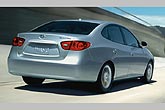Recent Articles
Popular Makes
Body Types
2007 Hyundai Elantra First Drive
Add style and substance to the Koreans' repertoire
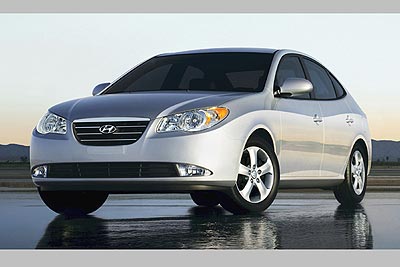
Hyundai Elantra – First Drive: In a previous position at a different publication where long-term cars were company-owned and not donated by the automakers' public relations departments, I vetoed a staff decision to lease a Volvo S60 instead of a Hyundai Elantra. This did not make me a popular person. We had just turned in a BMW 328i and my spoiled cadre of writers and editors wanted another luxury sport sedan to tool around in for two years. The new Volvo was a natural to fill the slot vacated by the BMW, they argued. However, Hyundai had just launched a redesigned Elantra with a terrific powertrain warranty, and it was my duty to keep the team and the content we produced sharply focused on the consumers who trusted us to tell them what cars to buy instead of what would make us look good rolling down Wilshire Avenue. To my knowledge, no publication had ever conducted a long-term test on a Hyundai so I decided that the time had come to test the Korean automaker's mettle. When our silver Elantra GLS sedan arrived, I gave the team this instruction: Beat on this car has hard as possible each and every time you drive it. Try to break it. Aside from normal maintenance, which was cheap, nothing went wrong with that long-term Elantra unless you count the shift pattern decal which loosened and fell off the shift knob. After a wide variety of drivers with varying levels of driving skill had flogged it, my brother bought the Elantra at a deep discount and took it to Arizona. It spent four years in the heat and the dust, suffering indifferent care and infrequent oil changes. Yet it ran and ran and ran, needing only a new battery, tires, brakes, wiper blades, and other normal maintenance items over the years. There was a recurring "check engine" light problem, but unscrewing and then tightening the fuel cap reset the system most of the time. The car is gone now, traded for an Infiniti G35 that is babied rather than bullied, but that old Hyundai is likely serving another owner in the same unfailing manner it did my brother. Proven durability is one reason I think the completely redesigned 2007 Hyundai Elantra is a terrific bet in the small car marketplace. Other reasons include its stylish sheetmetal, its comfortable and quiet interior, its impressive ride and handling, the quality of its construction, and its 10-year/100,000-mile powertrain warranty. Small cars are more popular than ever with recent fuel price fluctuations, but they aren't penalty boxes like they were ten years ago. Many cars in the sub-$20,000 price range are just as nice inside and drive just as capably as those approaching $30,000. The new Hyundai Elantra is one of those cars, and further evidence that the Koreans have figured out how to build world-class automobiles.
Model Mix
Model Mix The Hyundai Elantra sedan is offered in GLS, SE, and Limited trim levels. The GLS with the optional Preferred Package is expected to make up half of all Elantra sales. The five-door hatchback is on hiatus, but Hyundai indicates it will make a return in the future. Hyundai expects half of all Elantra sales to be the entry-level GLS model equipped with the Preferred Package. That car will include standard GLS equipment such as power windows, power door locks, power heated side mirrors, remote keyless entry, a tilt steering wheel, a height-adjustable driver's seat, and a 60/40 split folding rear seatback. The Preferred Package will add air conditioning, a 172-watt stereo with a CD/MP3 player and XM satellite radio with a free three-month trial subscription, an auxiliary input jack for an iPod or similar device, cruise control, fog lights, dual illuminated visor mirrors, front sunvisor extensions, and a shade band on the windshield. A power sunroof is optional when the Preferred Package is ordered. A Hyundai Elantra GLS has a base price of $13,995 including the $600 destination charge, but that's the car without A/C or a stereo. We'd guess $16,250 for the volume model with an automatic transmission. If that sounds too high, consider the level of safety equipment that comes on every Hyundai Elantra, as well as the fact that the EPA classifies this new model as a midsize sedan due to an interior volume measurement that exceeds 110 cubic feet. Every Elantra has six airbags – dual front, dual front side-impact, and side curtains. There's also a four-wheel-disc braking system with ABS and electronic brake-force distribution, and active front head restraints designed to reduce whiplash. Stability control is not available, but Hyundai says that future Elantras will get it. In addition to the GLS, Hyundai offers the redesigned Elantra in SE and Limited trim levels. The Elantra SE starts at $16,295 and includes a leather-wrapped telescopic steering wheel, 16-inch alloy wheels wearing 205/55 all-season tires, steering wheel audio controls, and a trip computer. An optional Premium Package includes a power sunroof and heated front seats. Hyundai says future Elantra SEs will be tuned for sportier driving. The $17,295 Elantra Limited adds leather seating, heated front seats, and chrome decklid trim to the SE model. An optional Sun and Sound Package installs a power sunroof and a 220-watt premium sound system with a six-disc in-dash CD changer. Hyundai also plans to offer an optional Bluetooth wireless communications kit on the Elantra sometime next year. For now, the redesigned Hyundai Elantra is offered as a four-door sedan. What happened to the five-door hatchback, you ask? Hyundai indicated that a more fun and functional Elantra was coming in the future, but was not prepared to delve into details. If you're looking for a replacement for your current "poor man's Saab," stay tuned.
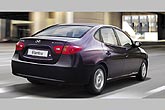
Nuts and Bolts
Nuts and Bolts Engine upgrades result in better fuel economy for the 2007 Hyundai Elantra. In California and New England, the Elantra is rated as a Partial Zero Emissions Vehicle (PZEV) when the engine is equipped with the optional automatic transmission. Pop the redesigned Hyundai Elantra's hood and under the handsome plastic shroud is an upgraded version of the 2.0-liter four-cylinder engine from the previous model. This is not the new "world engine" that Hyundai jointly developed with DaimlerChrysler – production constraints exclude that powerplant from the Elantra for now. In the meantime, this proven carryover motor gets several upgrades for added refinement and improved efficiency. Hyundai has added hydraulic motor mounts to better isolate the Elantra's somewhat buzzy engine from the cabin, and fuel economy is up this year. Hyundai says the Elantra gets an EPA rating of 28 mpg in the city and 36 mpg on the highway regardless of transmission choice, and when swapping the standard five-speed manual gearbox for the optional four-speed automatic in California or New England, the engine emissions rating escalates from ULEV (Ultra Low Emission Vehicle) to PZEV (Partial Zero Emission Vehicle). That greener emissions rating has an effect on horsepower and torque. In federal form, the ULEV-rated engine makes 138 horsepower at 6,000 rpm and 136 lb.-ft. of torque at 4,600 rpm. The PZEV-rated engine loses six ponies and three pound-feet of twist. Hyundai says the standard ULEV engine with a five-speed manual will accelerate the 2,723-pound Elantra from zero to 60 mph in 8.8 seconds. Our test sample was the PZEV version with the four-speed automatic, which did not accelerate that fast. Nevertheless, we found it to be peppy and able to return an average of 29.7 mpg in mixed driving. Standard 15-inch wheels with steel styled wheel covers and 195/65 tires or optional 16-inch alloy wheels with 205/55 tires are connected to a four-wheel-independent suspension with twin-tube gas-charged shocks. MacPherson struts are located up front, while the rear is comprised of a multi-link design. Hyundai swaps out conventional hydraulic steering for MDPS, which stands for Motor Driven Power Steering. This rack-and-pinion design adds incrementally to the Elantra's improved fuel economy, and causes no loss in road feel or steering response. Four-wheel ventilated front and solid rear disc brakes with ABS and EBD are also standard equipment, and Hyundai is working on getting a stability control system added to the Elantra.
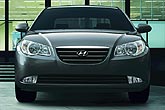
Design
Design Designed in California rather than Korea, the new Hyundai Elantra is a good looking little car. The interior, however, is even more impressive. Materials and décor are almost good enough for an entry-luxury sedan. Credit Hyundai's California design studio with the Elantra's stylish new look, which replaces the odd and dowdy appearance of the previous-generation model. Hyundai calls the Elantra's styling "expressive" and "sophisticated," and I agree. In my opinion, the Elantra is more appealing than the strange Honda Civic, better proportioned than the angular Nissan Sentra, and more curvaceous than the dull Toyota Corolla. Inside the Elantra, where it's hard to find cheap materials, designers have done an even better job. Aesthetically and ergonomically, the cabin's design and décor provide an upscale feel that makes the sticker price look like a bargain. Hyundai makes a big deal about the blue backlit gauges and controls, which certainly are soothing at night and worth the $50 per car the company claims it costs to install, but it's the level of refinement, the attention to detail, and the feel of the fabrics and plastics that most impressed me. A $55,000 Cadillac Escalade has a hard plastic dashboard, but our $16,780 Elantra SE's instrument panel was composed of soft-touch plastic. Additionally, the headliner was a classy woven mesh fabric, the cloth upholstery was plush and tastefully patterned, the plastic vent bezels and control surrounds were coated with a substance that made them feel substantial, and the silver interior trim did a good job of emulating real aluminum. Better yet, none of the plastic trim showed rough edges like it does in similarly-priced vehicles. Top it all off with a tasteful two-tone décor scheme, and the Elantra does a fairly good impression of an entry-level luxury car. Comfort levels are high, too, thanks to supportive seats with relatively tall hip points and a softly padded center armrest that puts the hard plastic one in a Saturn AURA to shame. Add the Elantra's simple, logical, and clearly marked controls to the equation, and this is one compact car that makes its driver feel as though she's living large. Well, up front, anyway. Despite the EPA's "midsize" rating, knee room is tight in the back seat when four six-footers are aboard. The standard center armrest with two integrated cupholders is a nice touch, though. Previous-generation Elantra owners complained about interior storage space, so Hyundai made sure the redesigned model addressed this concern. In addition to the large glovebox and adequate center console bin, Hyundai provides a purse hanger on the dashboard, a sunglasses holder in the overhead panel, a tray just forward of the shifter and convenient to the auxiliary input jack, generous door bins with integrated bottle holders, and dual rear map pockets. There are also two covered bins: one in the top of the dashboard and one just below the climate controls. Trunk space is also generous at 14.2 cubic feet, though the cargo area is cheaply outfitted and lacks a close assist handle for the lid.
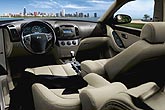
Driving Impressions
Driving Impressions Drive the new Hyundai Elantra, and you're likely to be impressed by how quiet it is, how stable it is, how responsive it is, and how comfortable it is. You are not likely to be impressed by how fast it is. Except for loud engine drone under acceleration, the new Hyundai Elantra is an impressive vehicle to drive. It's quite refined for a small car, remarkably quiet on the highway and displaying a good feel for the road. The engine is peppy and the automatic transmission shifts unobtrusively but wastes no time in responding to requests for additional power when passing or accelerating into traffic. However, though the Elantra has no trouble keeping up on city streets or cruising at 80 mph on the Interstate, this is not a quick car by any means. Ride quality is compliant and controlled while the steering is light at low speeds and exhibits a pleasing heft at higher speeds. The turning circle is tight for greater urban maneuverability, the steering communicates road textures to the driver's fingertips, and the leather-wrapped steering wheel on our Elantra SE test model was pleasing to hold. We found the Elantra to be an impressive handler, but admittedly did not push it hard on twisty two-lane sections of the driving route. If there's anything to complain about with regard to the Hyundai Elantra's dynamics, it's the brakes. They are extremely effective, reacting instantly to input, which makes them a bit grabby until the driver acclimates. Better this calibration, however, than a pedal that does little but illuminate the brake lights when stepped upon. Thanks to simple, logical control layout, the Elantra's large and well marked knobs, switches, and buttons make living with this car easy. The three rotary climate knobs, for example, are models of perfection. Also, note the fluidic refinement with which the controls operate, from the turn signal stalk to the dampened door covering the storage cubby in the center of the dashboard.
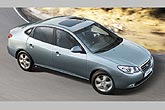
Specifications
Specifications The Hyundai Elantra's main competitors include the Chevrolet Cobalt, Ford Focus, Honda Civic, Kia Spectra, Mazda 3, Mitsubishi Lancer, Nissan Sentra, Saturn Ion, Suzuki Forenza, and Toyota Corolla Test Vehicle: 2007 Hyundai Elantra SE Price of Test Vehicle: $16,780 (including the $600 destination charge) Engine Size and Type: 2.0-liter inline four-cylinder with variable valve timing Engine Horsepower: 138 at 6,000 rpm (132 at 6,000 rpm for PZEV engine) Engine Torque: 136 lb.-ft. at 4,600 rpm (133 lb.-ft. at 4,600 rpm for PZEV engine) Transmission: Four-speed automatic Curb weight, lbs.: 2,800 (estimated) EPA Fuel Economy (city/highway): 28/36 mpg Observed Fuel Economy: 29.7 mpg Length: 177.4 inches Width: 69.9 inches Wheelbase: 104.3 inches Height: 58.3 inches Leg room (front/rear): 43.5/35 inches Head room (front/rear): 40/37.6 inches Max. Seating Capacity: Five Max. Cargo Volume: 14.2 cu.-ft. Competitors: Chevrolet Cobalt, Dodge Caliber, Ford Focus, Honda Civic, Kia Spectra, Mazda 3, Mitsubishi Lancer, Nissan Sentra, Saturn Ion, Subaru Impreza, Suzuki Forenza, Toyota Corolla, Volkswagen Jetta
Photos courtesy of Hyundai
